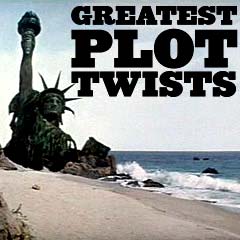|
Greatest Movie Plot Twists, Spoilers
and Surprise Endings
|
|
Title Screen
|
Film Title/Year and Plot Twist-Spoiler-Surprise Ending Description |
Screenshots
|
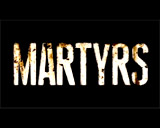
|
Martyrs (2008, Fr/Can.)
 Young
Females Were Tortured By A Quasi-Religious Group, Led By Mademoiselle
- They Were Believers Who Were Searching for A Rare True Martyr Who
Could Achieve Euphoric Transcendence or Transfiguration And See Beyond
Death; Anna Achieved Transfiguration After Excruciating Suffering,
and Her Testimony Caused Mademoiselle to Commit Suicide Young
Females Were Tortured By A Quasi-Religious Group, Led By Mademoiselle
- They Were Believers Who Were Searching for A Rare True Martyr Who
Could Achieve Euphoric Transcendence or Transfiguration And See Beyond
Death; Anna Achieved Transfiguration After Excruciating Suffering,
and Her Testimony Caused Mademoiselle to Commit Suicide
Writer/director Pascal Laugier's unrated, gory, nihilistic
horror film was accused of being one of the most violent movies ever
made - part of a hardcore trend in French films called the
"New French Extremism" that portrayed intense pain, hatred
and suffering. Its premise was that spiritual transcendence was just
beyond the horizon of ultimate pain.
The controversial film was similar to the graphic, torture-porn
film franchises in the US begun with Saw (2004) and Hostel (2005),
although more compelling with greater intellectual significance. When
the divisive film debuted at the Cannes Film Festival in 2008, it caused
many audience members to walk out. The final 15 minutes of the unpleasant
film was considered unflinchingly horrendous in its portrayal of cruelty.
The plot was a brutal tale about abducted, abused (although
there were no signs of sexual abuse) and badly-battered young 10 year-old
Lucie Jurin (Jessie Pham as youth) who - in 1971 - escaped from her
chained captivity in a torture room-chamber in an abandoned, unused
brick slaughterhouse. Found malnourished, dehydrated, bloody and bruised,
half-clothed, filthy, and starving after running down a road, she was
hospitalized in pediatric services. She was observed as suffering from
"malnutrition, dehydration, mild hypothermia." She was placed in an
orphanage, where she developed a close friendship with another abused
victim Anna (Erika Scott as youth).
Lucie felt haunted and terrorized by an imagined, nightmarish,
ghoulish, masochistic pale-skinned Creature (Isabelle Chasse) - a scarred,
scrawny, filthy, emaciated, stringy long-haired female who caused mutilations
and flesh wounds.
Fifteen years later in 1986, 25 year-old Lucie Jurin
(Mylène
Jampanoï as adult) sought revenge for the individuals who abused
a decade and a half ago. She came upon an isolated house and savagely,
cold-bloodedly murdered with a shotgun an entire middle-class French
family on a Sunday morning - the Belfonds (the two teens: high-school
athlete Marie and college-bound Antoine, and Mr. Belfond and his wife
Gabrielle). The crazed killer shook the dead bodies
of the two adults and asked about her previous torture: "How
could you do that to me?"
Afterwards,
she phoned her friend Anna Assaoui (Morjana Alaoui as adult) and told
her that she had vengefully killed who she believed were her tormenting,
sadistic captors from years earlier.
Abruptly after the murders, Lucie who had apparently
gone insane, had another envisioning of the Creature, who remained in
the house and wounded Lucie.
[Lucie seemed to be consumed with overwhelming psychological
guilt represented by the Creature. During Lucie's escape 15 years earlier,
she had left behind another bound female torture victim, and pleaded: "Forgive
me, it's not my fault."]
Lucie
was slashed and hacked at with a sharp-edged razor on her back
and left wrist. Anna arrived at the house, stitched her up, and then
Lucie helped her clean up the murder scene. They dragged the four bloody
corpses to the bathroom before Anna dumped them into a muddy pit-hole
outside. The Creature attacked a second time, seemingly
unappeased by the slaughter.
Meanwhile, Anna realized that Gabrielle Belfond was still
alive, and tried to keep it a secret from Lucie and help her escape.
But Lucie found them and mercilessly smashed in Gabrielle's head with
a hammer.
The Creature returned and
the suicidal Lucie felt that she would never find rest from her torment
and insanity. She slit her own arms with a razor blade, jumped through
a glass window, and remorsefully ripped open her own throat with a
box-cutter - giving her peace when she died in Anna's arms in the pouring
rain. Melancholy about the death, Anna remained in the home through
the next day.
A number of twists and surprises occurred in the film
from this half-way point forward:
- Anna discovered stairs behind a cabinet in the house,
leading to an underground chamber. Pictures of female torture victims
(martyrs) lined the corridor of the laboratory. Down another trap
door, she found where a real, imprisoned 'Creature' was chained
up - she came upon the tortured woman, named Sarah Dutreuil, with
scars and a metal blindfold contraption nailed to her head. Anna
brought her up into the house, gave her a bath, and attempted to
painfully remove the steel bolts from the blindfold
- Strangers dressed in black arrived and shot the raving,
maniacal 'Creature,' then took Anna as their new prisoner. The six
corpses (the Belfonds, Lucie, and Sarah Dutreuil) were buried in
the pit
- Anna was introduced to the depraved leader of a
secret torture society - elderly Mademoiselle (Catherine Bégin),
who believed that the quasi-religious group could learn from a tortured
and suffering young woman, although most-times, they frustratingly
only created "victims"; after a long period of torture and degradation,
most subjects, such as Sarah, would "see things that don't exist" such
as creatures, monsters, or cockroaches
- Mademoiselle believed they
could discover the secrets of the afterlife through their experiments
by finding a true martyr - a subject who would achieve
a state of euphoric transcendence:
"Martyrs are very rare. A
martyr is something else. Martyrs are extraordinary beings. They
survive pain, they survive total deprivation. They bear all the sins
of the earth. They give themselves up, they transcend themselves...
they are transfigured. It turns out that women are more responsive
to transfiguration. Young women."
- The society was responsible for Lucie's kidnapping
and torture as a child, and Gabrielle Belfond was her primary torturer.
- Anna was chained up in the same concrete cell where
she had found Sarah (and where Lucie had been tortured); she was force-fed
greenish slop, slapped, and regularly brutalized; her hair was cut
and she was sponge-bathed; eventually she submitted without resistance,
hallucinated, and heard voices, presumably from Lucie:
"You're not scared anymore"
- For the final stage of her suffering, in the film's
last 15 minutes, Anna was dragged away, clamped down to a steel medical
gurney, and her skin from her entire body (except for her face) was
flayed by a surgeon while she was alive - this caused her to achieve
transfiguration; the camera burrowed deep into Anna's dilated iris
to portray her agonizing ecstasy
- Mademoiselle was summoned to Anna's side, and
asked: "Did you see? The other world?" Anna whispered something unintelligible
into her ear
The members of the secret society were summoned to
the house to learn of Anna's "authentic martyrdom" on the previous
day. Anna was praised as being only the 4th individual in 17 years
to have attained the stage of martyrdom, and the first to relate
what she had seen. She had experienced a state of ecstasy lasting
2 hours and 15 minutes. Although still alive, she was
now no longer communicating.
Just before revealing Anna's insightful
testimony - what Anna had whispered about the afterlife (what "lay
beyond death") - Mademoiselle spoke to her assistant Etienne (Jean-Marie
Moncelet) and claimed that Anna's words were "very clear" and "precise"
with "no room for interpretation." Mademoiselle attempted to speak about
the indescribable, the unspeakable horror of what came after death:
Mademoiselle: "Could
you imagine what there is after death?"
Etienne: "Are you okay?"
Mademoiselle: "Could you?"
Etienne: "No, I..."
Mademoiselle:
"Keep doubting." (She
placed a gun in her mouth and shot herself)
The film ended abruptly, with the definition
of "martyr" - "noun, from the Greek 'marturos': witness" |

Abused, Tortured 10 year-old Lucie (Jessie Pham)

25 year-old Lucie Jurin (Mylène Jampanoï)
Murdering Her Abusive Belfond Family

Imaginary 'Creature' (Isabelle Chasse)

Tortured 'Creature' Woman Sarah With Removed Metal Blindfold

Anna Assaoui (Morjana Alaoui)

Mademoiselle (Catherine Bégin)


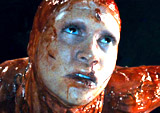
Anna's Martyrdom and Torture, Including Skinning

Anna Whispering To Mademoiselle

Mademoiselle Committing Suicide
|


|
Masquerade (1988)
 Three
Co-conspirators Had Plotted Together For A Long Time to Murder Wealthy
Heiress Olivia Lawrence; By Film's End, All Three (Including Olivia's
Recent Husband) Ended Up Dead Three
Co-conspirators Had Plotted Together For A Long Time to Murder Wealthy
Heiress Olivia Lawrence; By Film's End, All Three (Including Olivia's
Recent Husband) Ended Up Dead
Director Bob Swaim's R-rated, plot-twisting, psychological
sex-filled thriller was about murder, greed, double-crossing deception,
surprise deaths and betrayal. There were notable bombshell twists
in the film's final one-third. There were notable bombshell twists
in the film's final one-third, including the deaths of all three
co-conspirators who had plotted together for a long time to murder
a wealthy heiress.
The film's title referred to the name
of a yacht anchored off the Hamptons, and to the deceptive nature
of many of the characters. The film's tagline hinted at the plot:
An heiress.
A hustler.
A set-up.
A murder.
MASQUERADE - It's not a game anymore.
The main mystery story centered around an heiress and
the circumstances swirling around her in Southhampton, Long Island,
due to her estate/trust wealth of $300 million:
- Olivia Lawrence (Meg Tilly), a wealthy, naive, shy,
vulnerable and dreamy Hampton heiress who was forced to live with
her scheming, alcoholic and despicable stepfather Tony Gateworth
(John Glover), a dissolute Atlantic City gambler, who was accompanied
by his new live-in girlfriend-companion Anne Briscoe (Dana Delany)
Olivia had recently been orphaned following the death
of her mother a few months earlier, and Gateworth now served as her
spiteful 'guardian.' After recently graduating from college, Olivia
met two possible suitors on her return home:
- Tim Whalen (Rob Lowe, just before he was involved
in a sex tape scandal), a playboyish, callow sailing instructor
and racing yacht skipper/captain with another lover on the side
- Brooke Morrison (Kim Cattrall)
- Mike McGill (Doug Savant), a grown-up children friend,
now an amiable Hampton Shores police officer who always had a romantic
interest in Olivia and dreamed of marrying her one day
While becoming acquainted with Olivia, Tim was also
involved with another lover - in one of the earliest scenes:
- Brooke Morrison (TV's Sex and the City's
Kim Cattrall), the sex-crazed, bored and lustful wife of Tim's
wealthy boss Granger Morrison (Brian Davies), who owned a racing
sailboat Obsession captained by Tim
After meeting and sailing together on Masquerade,
the name of the boat owned by her deceased father, Olivia and Tim
began to date and fell in love.
The storyline became quite complicated due to conspiratorial
plans or plots to murder Olivia, to acquire her fortune:
- Gateworth and Tim Whalen were partnered
and plotting together to eliminate Olivia; they met together in
a diner, where Tim stated he would convince Olivia of his hatred
of Gateworth and gain her confidence so that his courtship and
marriage to her were assured
|
Three Main Co-Conspirators in the Plot
|

Tim Whalen (Rob Lowe)
|

Mike McGill (Doug Savant)
|

Tony Gateworth (John Glover)
|
Olivia and Tim experienced a night of passionate sex
in her mansion when Gateworth was scheduled to be away.
- in the execution of their plot, when
the drunken, weapon-wielding Gateworth burst into their bedroom
just after they had made love, Tim engaged in a brief struggle
with Gateworth, and double-crossed him by shooting him to death
with his own gun
- Olivia volunteered to cover up Tim's role by claiming
she killed the drunken Gateworth in self-defense with his gun -
believing he was a burglar-rapist, and hoping it would be ruled
a "justifiable homicide"; at the crime scene, investigating
cop Mike found two wine-glasses by the bedside - evidence that
could incriminate Tim, and he hid it from detectives (due to his
love for Olivia), while suspecting that Tim had killed Gateworth
- shortly later, Tim's lover Brooke, after dumping
him, substantiated Tim's fake alibi that she was with him from
11:30 pm onward at the time of the murder (he had reset her bedroom
alarm clock without her knowing)
- after confessing to Olivia that he had an affair
with Brooke, and that his past included bouncing checks (and 30-day
jail time), Tim convinced her that he was open and truthful with
her - and the couple married; soon after, Olivia became pregnant
- Gateworth's girlfriend Anne was asking lots of questions,
and becoming overly suspicious about Olivia's boyfriend Tim (she
also knew of Tim's unlikely meeting in a diner with Gateworth);
she was found hanged above her bathtub - with a typed and unsigned
suicide note (presumably killed by McGill, to be blamed on Tim)
- treacherous officer Mike McGill was revealed to
be implicated with Tim in a conspiracy to kill Olivia (the spiteful
McGill admitted: "I spent a whole year of my life setting this thing up");
he wanted to stage a deadly car accident on a curvy road into a tree
(on an oiled-up surface), but Tim balked at the idea of murdering
Olivia, now that she was pregnant, and maneuvered through the slick
patch without incident
- a photo on a bulletin board in McGill's Marine office
showed the threesome (Gateworth, McGill, and Tim) had been associated
with each other (through sailing) for many years - and had probably
always been plotting to separate Olivia Lawrence from her money;
it was very probable that McGill and Tim were bi-sexual lovers,
but when Tim was seduced away by Olivia, Tim's fury about unrequited
love (from both Olivia and Tim) caused him to carry through on
the plan
- Tim planned to sail for Palm Beach, Florida on Masquerade with
Olivia a few days earlier than he had told McGill; on the day of
their sailing, Tim lost his life trying to warn Olivia; he raced
onto the yacht before she arrived and turned off the propane gas,
but then inadvertently flicked a switch that triggered McGill's
rigged gas-line explosion
- Olivia figured out the conspiracy against her by
the trio (she saw the photo in the McGill's Marine office), confronted
McGill, and pushed him out of the office window to his death below
|
The Film's Shocking Ending
|

Tim's Death in Masquerade Explosion
|

McGill's Death - Pushed Out Window by Olivia
|
Olivia didn't know all along
whether to trust Tim - did he love her truly, or was he marrying her
only for her money? By the film's conclusion, although Olivia had thought
that Tim had betrayed her, she learned otherwise that his love wasn't
a masquerade. At Tim's funeral, she discovered from her family attorney
Theodore Cantrell (Pirie MacDonald) that her dead husband had asked
to be removed from her will two weeks earlier - proving his true love
for her and that he had sacrificed himself for her:
"He made me swear that I wouldn't tell you, but
now with what's come out, you have to know. I think somehow he wanted
to have all temptations removed. I tried to dissuade him, told him
it was against your wishes, but he was adamant. He wanted nothing
from you. He loved you, Olivia. However it started, he came to love
you."
|

Olivia Lawrence (Meg Tilly)

Tim Whalen and His Lover Brooke Morrison (Kim Cattrall)
- After Sweaty Sex

Olivia Sailing on Masquerade with Tim Whalen (Rob
Lowe)



Passionate Love-Making Between Olivia and Tim Whalen

In Olivia's Bedroom, the Death of Gateworth - Shot by
Tim and then Covered-Up


Olivia and Tim - Now a Married Couple

Anne Briscoe's Death (Suicide?)

McGill Plotting with Tim to Kill Olivia

B/W Photo Showing Threesome's Association
|

|
Match Point (2005)
 Married Man Chris Escaped Charges of Murdering His Pregnant Mistress Nola,
By A Few Lucky Strokes of Fate. His Staging of a Drug-Related Burglary
In Nola's Apartment Building Ended With The Shotgun Murders of Both
Nola and Her Next-Door Neighbor Mrs. Eastby. Chris Admitted to Scotland
Yard That He Had Committed Adultery But Not Murder, After They Found
Nola's Diary. Luckily For Chris, a Known Junkie-Drug Dealer Had Found
Mrs. Eastby's Discarded Gold Ring (And Put it in his Pocket), Was
Then Murdered - and the Authorities Pinned the Crime on Him. The
Case Against Chris Was Closed. Married Man Chris Escaped Charges of Murdering His Pregnant Mistress Nola,
By A Few Lucky Strokes of Fate. His Staging of a Drug-Related Burglary
In Nola's Apartment Building Ended With The Shotgun Murders of Both
Nola and Her Next-Door Neighbor Mrs. Eastby. Chris Admitted to Scotland
Yard That He Had Committed Adultery But Not Murder, After They Found
Nola's Diary. Luckily For Chris, a Known Junkie-Drug Dealer Had Found
Mrs. Eastby's Discarded Gold Ring (And Put it in his Pocket), Was
Then Murdered - and the Authorities Pinned the Crime on Him. The
Case Against Chris Was Closed.
Famed writer/director Woody Allen's first R-rated dramatic-erotic
thriller, and his first film set and shot in England. The film, without
Allen's typical humor, recalled elements of A
Place in the Sun (1951), Body Heat (1981), Fatal
Attraction (1987), Allen's own Crimes and Misdemeanors (1989),
his future film Cassandra's Dream (2007), and similarities to
Dostoyevsky's Crime and Punishment 1866 novel. Its main tagline
was: "Passion, Temptation, Obsession."
The film began with a voice-over narration, a metaphoric
musing about chance, luck and fate - it was presented with a side view
of a tennis net and the freeze-frame shot of a tennis ball suspended
in space over the net - poised to fall on one side or the other:
"The man who said, 'I'd rather be lucky than good,'
saw deeply into life. People are afraid to face how great a part
of life is dependent on luck. It's scary to think so much is out
of one's control. There are moments in a match when the ball hits
the top of the net, and for a split second, it can either go forward
or fall back. With a little luck, it goes forward, and you win. Or
maybe it doesn't, and you lose."
Chris Wilton (Jonathan Rhys-Meyers) was a handsome, recently-retired
Irish tennis pro from a poor background, and an instructor at an exclusive
London tennis club. He kick-started a privileged life when he began dating
Chloe Hewett (Emily Mortimer), the shy, sweet brunette heiress daughter
of Eleanor (Penelope Wilton) and Alec Hewlett (Brian Cox). Soon after,
Chris was appointed as an office-worker in the company of her father,
as part of a preparatory "grooming" process.
While with
Chloe and becoming acquainted with her wealthy family, Chris
met Nola Rice (Scarlett Johansson), a struggling, chain-smoking, blonde
and sexy femme fatale American actress from Boulder, Colorado.
She was the girlfriend/fiancee of Chloe's younger brother Tom Hewett
(Matthew Goode). Although he was about to marry
into the wealthy Hewett family, he was smitten with Nola. The first
steamy, clandestine tryst between Nola and Chris occurred shortly after
another of Nola's failed auditions. They both met up
in a wheat-field near the Hewlett country estate during a rainstorm,
and made love.
The affair with Nola ended after Tom admitted that he
had broken up with Nola (Tom: "I've met someone else"). Nola
was forced to return to the US to look for a job. Although Chris
was now a married man, he became obsessed with Nola when she returned
to London - and they continued their discreet affair. When Nola, ironically,
became pregnant, she adamantly refused to get an abortion, and she
threatened to reveal everything to Chloe. Chris contemplated murder
as a way out of his guilt-ridden, adulterous dilemma.
With a shotgun (broken down and hidden in his tennis
bag), Chris killed (off-screen) Nola's next-door apartment neighbor
Mrs. Betty Eastby (Margaret Tyzack), then staged a burglary in her
apartment. He also shot and killed Nola (off-screen) when she stepped
off the elevator after returning from work. Scotland Yard considered Chris
a suspect since he was often mentioned in Nola's diary. He denied being
a murderer, although he did admit to being an adulterer.

|

|
|
Two Juxtaposed Images - The Tennis Ball and the
Gold Ring
|
Luckily for Chris, the gold ring (that he had discarded
from the burglary into a river - and coincidentally fell back onto
a sidewalk) was picked up by a known drug dealer-addict (a junkie who
was later found murdered) and the drug-related burglary-crime was pinned
on him:
"The
old woman's wedding ring was right in his pocket...Name and date engraved
right on it."
The case against Chris was closed - he was guilty of
adultery, but not murder ("He's
another poor schmuck who cheated on his wife"). Meanwhile, Chloe's
baby boy was born - and her father Alec joyously toasted the boy: "With
parents like Chloe and Chris, this child will be great at anything
he sets his mind to." Tom retorted: "I don't care if he's
great. I just hope that he's lucky."
The final shot of the film
saw Chris troubled, standing apart and very disconnected from his happy
family. |

Chris Wilton (Jonathan Rhys-Meyers)

Chris With Nola Rice (Scarlett Johansson)


Chris and Nola Having Sex

Chris With Shotgun, Killing Nola's Neighbor to Stage a
Burglary

Chris Murdering Nola

Final Image of a Troubled Chris
|

|
Matchstick Men (2003)
 Roy
Didn't Have a 14 Year-Old Daughter Named Angela - She Was Part of an
Elaborate Con to Steal His Money; After Reconciling with Angela,
It Was Revealed That Roy's New Pregnant Wife Was Supermarket Cashier
Kathy Roy
Didn't Have a 14 Year-Old Daughter Named Angela - She Was Part of an
Elaborate Con to Steal His Money; After Reconciling with Angela,
It Was Revealed That Roy's New Pregnant Wife Was Supermarket Cashier
Kathy
Director Ridley Scott's crime drama was about two
professional, small-time LA con-men, who were swindlers selling cheap
water-filtration systems and filters - with bogus prizes:
- Roy Waller (Nicolas Cage), a veteran grifter
- Frank Mercer (Sam Rockwell), Roy's younger
protege
Roy's schemes were threatened because of his obsessive-compulsive
traits, neurosis and panic attacks, growing mental illness and depression,
and agoraphobia. During psychoanalysis with a new psychiatrist, Dr.
Harris Klein (Bruce Altman), Roy learned that he had a long-lost,
14 year-old teenaged "daughter," now Angela
(24 year-old Alison Lohman). He thought she was conceived
before he split 14 years earlier from his ex-wife Heather (Melora
Walters).
[Note: Heather had actually suffered a mis-carriage,
a fact that Roy learned only later in the film.]
After Roy met pig-tailed Angela at an outdoor park,
he took her to get something to eat, when she thought he was an ex-con,
but then forgave him: "lt's okay, you know. Whatever you do. Everybody's
done something bad in their life." She
had an excuse to move in with Roy for one weekend, during which time
she prophetically told him: "I'm
not as innocent as you think, Roy. I've done stuff with boys. I've
done stuff with boys if I told you, you'd probably throw up right
here."
After
an elaborate scheme that bilked Roy out of his own money (stashed
in a plastic doggie bank in his living room), he learned that blonde
Angela was part of the scam (to trick him into believing she was his
daughter). Angela was part of the con to have him
trust in her, so that the cons could completely fool Roy and steal
all of his money. The scam involved at least three others, including:
- Frank Mercer, Roy's younger con partner
- Dr. Klein, Roy's psychiatrist
- Chuck Frechette (Bruce
McGill), a businessman, Roy's new target-mark
In the surprising conclusion one year later, the ultimate
'con' of sorts, it was revealed that the betrayed Roy was working
a legitimate job as a rug salesman and that he had turned his back
on crime and con-games. He was virtually cured of his extreme obsessive-compulsive
disorders.
He happened to meet an apologetic,
dark-haired Angela in his store with her slacker boyfriend purchasing
a rug. Roy didn't mention her previous scams in the presence of her
boyfriend, although Angela claimed that she had "retired...that
was a one-time deal," but she complimented him for being a
great scam-teacher. He added: "l'm kinda surprised
to see you here. l figured you would have moved out to, uh, l don't
know, Hawaii." She replied: "l kind of got screwed on my
cut. You know Frank" - something he said was not unusual in
the con business: "You're
gonna go swimming, you're gonna get wet, right?" (using a phrase
she had spoken before).
Then, he complimented her: "You changed your hair.
Makes you look grown-up," and then she abruptly apologized: "l'm
sorry too, if it's any consolation. You mad at me?" He then
forgave her:
Roy: You didn't take it. l gave it to you.
Angela: lt's a funny
way of looking at it.
Roy:
Well, l see things differently now...
Angela:
We had
a good time, didn't we?
Roy:
Yeah, we did.
Angela:
lt's good to see you, Roy.
Roy:
lt's good to see you too.
As she left, she called him: 'Dad.'
Then it was revealed
what Roy's new life was like. After buying groceries, he drove home,
where his slowly-developing love interest had been fulfilled with
long-haired brunette Kathy (Sheila Kelley) - the observant cashier
at the supermarket throughout the film (from whom he bought canned
tuna, cigarettes, and ice cream). She was his new and pregnant wife
- he kissed her and listened to her pregnant belly, to the
tune of Frank Sinatra's "Summer
Wind." |


Roy Waller (Nicolas Cage)


14 year-old Angela (Alison Lohman)



Angela at the Rug Store One Year Later - An Apology
to Roy


Roy's New and Pregnant Wife Kathy (Sheila Kelley)
|
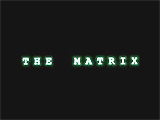
|
The Matrix (1999)
 Neo
Was the One, Who Defeated the Sentient Agents and Saw the Matrix As
It Really Was Neo
Was the One, Who Defeated the Sentient Agents and Saw the Matrix As
It Really Was
The main character in Andy and Lana Wachowski's dystopian,
action-adventure sci-fi film, the first in a franchise of three films,
was an individual who was living two lives:
- Thomas Anderson (Keanu
Reeves), a computer programmer
- Neo ('Neo' was Thomas Anderson's hacker
alias), a computer hacker
He was eventually contacted by two individuals, who
told him about the "Matrix" - and how the real world was only artificial
and illusory - and actually a ravaged wasteland with subdued human
beings:
- Trinity (Carrie-Anne Moss), black leather-clad,
a hacker
- Morpheus (Laurence Fishburne),
a mysterious, legendary cyber-terrorist freedom fighter and 'fatherly'
mentor
Neo chose to take a red pill from Morpheus, after
which he went down the "rabbit
hole" - essentially, he learned that the Matrix was a fabricated,
illusory dream world created by an intelligent, mechanized and artificial
life form. The race of machines was using enslaved, but unaware
humans as its power source for heat and electricity.
Trapped humans
were grown in liquid-filled pods and connected to the Matrix with cybernetic
cables and implants, to provide the machines with an energy source.
Morpheus and other rebels "unplugged" enslaved
humans and recruited them as rebels.
According
to the Matrix's premise, the world was really a virtual reality computer
program that actually existed in the 22nd century. Neo was informed
that only a small number of freed, rebellious humans (Morpheus, Trinity,
Switch, etc.) really lived in the real world -
in an underground city and refuge called Zion. As a rebel against the
machines, Neo was compelled to return into the Matrix and confront
the agents - super-powerful computer programs who were intent on
eliminating Neo and the entire human rebellion against them, and
whose main objective was to keep humans entrapped in the Matrix.
The Messianic figure Neo
(the "One")
was called upon to save and liberate humanity from indestructible government
agents - powerful sentient software programs, such as villainous, sinister,
black-suited lead Agent Smith (Hugo Weaving), by hacking into the Matrix,
'unplugging' other humans, and recruiting them for further resistance.
Neo learned the true nature of the simulated reality
- and was able to have control over the Matrix. In doing so, he was
able to dodge bullets (with slow-motion "bullet
time"), bend the laws of physics, and attain
superhuman powers.
He was able to perform impossible feats of physicality
(such as running up walls or leaping impossibly high) and alter his
perception so dramatically that he saw bullets in flight in order to
dodge them.
The Oracle (Gloria Foster), however,
told him about how he might not be the One - the prophesied, gifted
individual who would lead the insurrection of enslaved humans against
the machines:
"You got the gift,
but it looks like you're waiting for something."
Many of the crew
members of the Morpheus's hovercraft Nebuchadnezzar in the real-world
were killed (Dozer, Apoc, and Switch) when disillusioned Cypher (Joe
Pantoliano) betrayed the group to Agent Smith. Soon after, however,
the traitor was killed by wounded crew member Tank (Marcus Chong).
Neo was shot dead by Agent
Smith (within the Matrix) during an ambush, but a kiss
from Trinity's lips revived and reawakened him. Neo stood up, raised
his arm, and the palm of his hand resisted more of the agents' bullets
in mid-air.
As the One, he finally understood that the bullets
fired against him were not real. He
saw the Matrix as it really was - it was solely lines of downward-streaming
green and white computer code (or 'digital rain').
He realized that
he was actually the One, left to singlehandedly conquer, vanquish,
and literally destroy Agent Smith in the film's conclusion. Neo thwarted
Agent Smith's goal to stop him from getting out of the
Matrix.
As Neo was revived, menacing "Sentinel" machines
were attacking and threatening the hovercraft, but Neo was able to
leave the Matrix just in time before the Sentinels were disabled
by the ship's electromagnetic pulse weapon. The Matrix could now
be controlled.
In the final scene within the green-tinged Matrix before
Neo flew away into the sky, he made an ominous telephone call from
a phone booth to the machine masters who were imprisoning humans
- he threatened to expose them and create a new world:
I know you're out there. I can feel you now. I know
that you're afraid. You're afraid of us. You're afraid of change.
I don't know the future. I didn't come here to tell you how this
is going to end. I came here to tell you how it's going to begin.
I'm going to hang up this phone. And then I'm going to show these
people what you don't want them to see. I'm going to show them
a world - without you. A world without rules and controls, without
borders or boundaries. A world where anything is possible. Where
we go from there is a choice I leave to you.

|

|

|

|
|
Neo's Threatening Phone Call Before Flying Away
|
|


Morpheus' Pill Choice


Humans Enslaved in Pods

"Bullet-Time"

Neo Shot Dead by Agent Smith

Trinity's Kiss

Resisting Bullets

The Matrix: Green Lines of Code


Destruction of Agent Smith (Hugo Weaving)
|
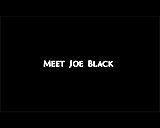
|
Meet Joe Black (1998)
 After
Escorting Bill Parrish Into the Afterlife at his 65th Birthday
Party, "Joe Black" Returned to Bill's Daughter Susan
in the Body of Its Previous Mortal Owner After
Escorting Bill Parrish Into the Afterlife at his 65th Birthday
Party, "Joe Black" Returned to Bill's Daughter Susan
in the Body of Its Previous Mortal Owner
Director Martin
Brest's tedious, manipulative and overly-long, dramatic romance-fantasy
film (loosely based on Death Takes A Holiday (1934)) began
with an introduction of the main characters, including:
- William "Bill" Parrish (veteran actor
Anthony Hopkins), an imperious mid-60-ish entrepreneur magnate,
the head media tycoon of Parrish Communcations
- Susan Parrish (Claire Forlani), Parrish's
daughter, a dark-eyed, vacuous, vulnerable and thin medical
student
- unnamed lawyer (Brad Pitt),
handsome and young attorney in Manhattan; he introduced himself
and struck up a friendly conversation with Susan in a NYC coffee
shop
However, his life was short-lived. In the middle of
the street as he turned to look back at Susan after she disappeared
around a building, the lawyer was
violently killed in a car accident when he was struck by one van and
then his body was tossed in the air into a taxi-cab.
Parrish
was given a negotiated reprieve of time from death by the voice of
Death for an undetermined amount of time during an appearance to
him in his home's library. Parrish was complimented for his frequent
dispensation of wisdom about love and life, and was chosen to be
Death's personal 'guide.' Death struck a deal with the dying Bill
Parrish, who was suffering from a bad heart, because Death wanted
to see what it was like to be mortal:
The great Bill Parrish at a loss for words? The man
from whose lips fall 'rapture' and 'passion' and 'obsession'?
All those admonitions about being 'deliriously happy, that
there is no sense living your life without.' All the sparks
and energy you give off, the rosy advice you dispense in round,
pear-shaped tones....It's only recently that your affairs here
have piqued my interest. Call it boredom. The natural curiosity
of me, the most lasting, and significant element in existence,
has come to see you...I want to have a look around before I take
you...It requires competence, wisdom and experience. All those
things they say about you in testimonials. And you're the one....Show
me around, be my guide. And in return, you get...Time: Minutes,
days, weeks. Let's not get encumbered by detail. What matters is
that I stay interested.
The lawyer's
body then reappeared - to join the dinner in progress. The dead lawyer's
body was taken over by an inarticulate, often silent personification
of the Angel of Death (also Pitt), and taking the name of "Joe
Black." Parrish
was to introduce Joe Black to new
things and experiences in earthly life, including the love of his daughter
Susan.
[Note: Although Susan was engaged to be married to
Parrish Communication's board member Drew (Jake Weber), she didn't
really passionately love him. Her father had advised her not to
rush into marriage: "Stay open. Who knows? Lightning could strike!" She
had actually met the young lawyer in a coffee shop just before
his startling death. When the lawyer's deceased body was inhabited
by Death and returned to 'life', she couldn't understand why he
acted so differently.]
Parrish's beloved daughter fell in love with the passionless,
metaphysical doppelgänger "Joe Black" in a doomed relationship.
By the end of the film, there was a strong mutual love between "Joe
Black" and
Susan. When Joe revealed his true identity to Susan
and she expressed distress, he abandoned his plan to take her away,
and decided to let her live her own earthly life.
Joe also exposed dishonest
business associate Drew as an undercover IRS agent trying to sabotage
Parrish's company by creating an "undisclosed conflict of interest...an
indictable offense." Drew was offered a deal to avoid jail time
- he must confess to the board every detail of his participation, and
then submit his resignation. Parrish was reaffirmed as the chairman of
the board of Parrish Communications, and the merger
with Bontecou International was rejected.
The film ended with a tear-jerking,
fireworks-filled conclusion, set at Bill's 65th birthday party celebration.
Parrish delivered a heart-warming speech to everyone:
I thought I was gonna sneak away tonight. What a glorious
night. Every face I see is a memory. It may not be a perfectly perfect
memory. Uh, sometimes we had our ups and downs. But we're all together
and you're mine for a night. And I'm gonna break precedent and tell
you my one-candle wish - that you would have a life as lucky as mine,
where you can wake up one morning and say, 'I don't want anything
more.' (Long pause) Sixty-five years. Don't they go by in a blink.
And then after one last dance with his daughter and a
hug, Parrish
met up with Joe Black, his afterlife escort. Parrish expressed his
gratitude to Joe for what he had done for Susan. The two walked over
a bridge into death on the horizon.
Joe
gave Susan a second chance at love by restoring his body to its previous
mortal owner, the coffee shop lawyer, and coming back to her across the
bridge. She knew nothing of their previous encounters when he represented
Death. They spoke a few words to each other, and then arm in arm,
watched the fireworks show celebrating her father's birthday:
Susan: We know so little about each other.
Joe:
But we've
got time.
Susan:
Yeah. I wish
you could've known my father.
Joe:
Me too. Me too.
Susan:
What do we do now?
Joe:
It'll
come to us.
Susan:
Yeah.
|

Susan Parrish (Claire Forlani)

Lawyer in Coffee Shop (Brad Pitt)

Bill Parrish's (Anthony Hopkins) Bad Heart

Death of Lawyer in Street

Death's Appearance to Parrish in His Library

The First View of Death - aka "Joe Black" (Brad
Pitt)

Parrish's 65th Birthday Party Speech

Last Dance with Daughter

To the Afterlife



The Return of the Lawyer to Susan
|
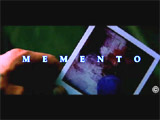
|
Memento (2000)
 Sammy
Jankis' Story Was Actually Leonard Shelby's Story; Leonard
Killed "Teddy" Gammell, Believing He Had Again
Successfully Avenged His Wife's Rape/Death by Killing the Second
Intruder - But It Was Leonard Who Had Killed His Own Wife (He Had
Forgotten Due to the Effects of Short-Term Memory Loss). He Had
Mistakenly Overdosed His Diabetic Wife With Insulin. She Did Not
Die At the Hands of the Rapist-Murderers in Their Bathroom Sammy
Jankis' Story Was Actually Leonard Shelby's Story; Leonard
Killed "Teddy" Gammell, Believing He Had Again
Successfully Avenged His Wife's Rape/Death by Killing the Second
Intruder - But It Was Leonard Who Had Killed His Own Wife (He Had
Forgotten Due to the Effects of Short-Term Memory Loss). He Had
Mistakenly Overdosed His Diabetic Wife With Insulin. She Did Not
Die At the Hands of the Rapist-Murderers in Their Bathroom
British writer/director Christopher Nolan's unique,
neo-noirish, thought-provoking, and originally-told puzzling who-dun-it
thriller was challenging and confusing in itself just to watch
due to its non-linear, backwards narrative structure. An earlier
film with the same technique of reversed events was Harold Pinter's Betrayal
(1983). The themes of this very disorienting and gimmicky film
were manipulation of a person's impaired memory and self-deception,
grief, repression, guilt and vengeance. The gimmick was intended
to convey the memory-confusion of the main protagonist, and pass
on some of his disorientation to the film viewing audience.
The original screenplay by director Nolan was based
upon a 2001 short-story ("Memento Mori" and published in Esquire Magazine)
written by his brother Jonathan Nolan. On a budget of $9 million,
the film made $25.5 million (domestic) and $40 million (worldwide).
Its tagline was: "Some memories are best forgotten."
A crucial fact about the smoothly-edited film was that
all the black and white inserted scenes in the film played in correct
chronological order, while the 22 fragmented color scenes (each about
five minutes in length) played in reverse order (although they were
chronological within the segment itself). The color scenes were the
main narrative of the story. The B/W scenes had all taken place before
any of the events shown in the color segments. There were also additional
flashbacks within some of the color and B/W segments. Both narratives
played separately and alternately until the film's climactic conclusion
when the two strands merged into a color sequence - at the time of
the strangulation of Jimmy Grantz.
The twisty film included mainstays of film noirs -
an unreliable narrator, a man in a dark, cruel and untrustworthy
world, and a quest to find the truth. In the main plot, the protagonist
was suffering from a chronic disorder known as anterograde amnesia
(aka Korsokoff's syndrome with an inability to form new memories
- i.e., short-term memory loss); he was investigating the brutal
and cold-blooded rape and murder of his wife during a late-night
burglary; (the main character suffered temporary amnesia during the
attack due to a blow to his skull); he proceeded to use his own self-inflicted
tattoos, professional tattoos, Polaroids, and cryptic notes to aid
his short-term memory and provide clues to finding a second intruder
who got away.
Things were further complicated by the fact that the
memory-impaired protagonist was being provided with faulty information
from two unreliable and manipulative characters who deliberately
lied to him, knowing that he would soon forget what they told him.
In two separate plot strands, the two deceitful characters had persuaded
the protagonist to believe that their murder targets (Dodd and Jimmy
Grantz (or John G)) were deserving because they were identified as
his wife's killer. Also, the plot element about the incident involving
the main character's wife was called into question - was she actually
raped and killed, or was she just raped, and then died due to overdoses
of insulin?
In fact, due to later revelations regarding the protagonist,
it was concluded that his final targeted suspect might have been
the 'wrong guy' and wasn't responsible at all for the death of his
wife. He may have mixed up certain facts and/or perhaps was in denial
about his own unremembered past. It was entirely possible, due to
the film's final sequence ("I'VE DONE IT") that the main
character was still incarcerated in an insane asylum (or had escaped)
and was imagining everything.
- at the conclusion of the title credits, a Polaroid
color photo of a murder scene (a bloodied body was on a floor)
slowly faded away and became UN-developed - providing a clue that
the film was running backwards, and emphasizing the film's theme
of fading memories; the photo was held by ex-insurance fraud investigator
Leonard Shelby (Guy Pearce) after he had committed a murder
- in the film's first scene (although it was located
chronologically at the end of the story due to its reversed order),
Leonard had just apparently killed his confidante/associate: "Teddy" Gammell
(Joe Pantoliano), a crooked SF undercover cop whose real name was
John Edward Gammel (John G); whether Leonard was right or not,
he believed that Teddy was one of the murderous burglars and perpetrators
of a hideous crime; the scene backpedaled to moments earlier when
Leonard drove Teddy to an abandoned warehouse, and was reminded
by notes on a Polaroid photo identifying Teddy that he must be
eliminated: "DON'T BELIEVE HIS LIES. HE IS THE ONE. KILL HIM"; he pulled
his gun on Teddy and vengefully threatened: "Beg my wife's forgiveness
before I blow your brains out"; Teddy vainly tried to dissuade
him: "You don't know what's going on. You don't even know my
name... You don't know who you are"
- in the film's reversed chronology, in the first
B/W segment (signifying a much earlier time period), Leonard was
viewed in Los Angeles in an "anonymous room" (# 21) at
the Discount Inn (actually, he was being ripped off and tricked
by motel clerk Burt (Mark Boone Jr.) into renting two rooms: #
21 and # 304); in the next color segment, he told the motel clerk
a little bit about his short-term memory loss issues due to a recent
head-skull injury: ("I have no short-term memory....I can't
make new memories"); he was also receiving phone calls from
an unidentified caller (presumably Teddy)
- due to his memory problems, Leonard had devised
clever methods to remember things and establish some sort of objectivity
about the world around him -- by writing notes, taking Polaroid
pictures, and tattooing messages on his body; the cryptic notes
included the following:
- a reminder to "SHAVE"
- a photo of his associate "Teddy"
- with the added note on the back: "Don't Believe His
Lies. He Is The One. Kill Him"
- a tattoo on his hand: "remember Sammy
Jankis"
|
Leonard's Meaningful Memory Device - Photos and
Tattoos
|
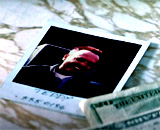
"Teddy"
|
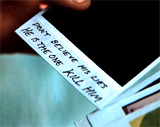
"Don't Believe His Lies. He Is The One. Kill
Him"
|
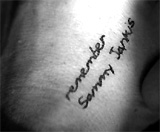
"Remember Sammy Jankis"
|

"Remember Sammy Jankis"
|
- at a restaurant, Leonard was given his own (2nd)
hotel room (# 304) key and a Polaroid photo of the Discount Inn
by femme fatale Natalie (identified later); inside his alternate
hotel room, Leonard was keeping track of clues with a wall-mounted,
hand-drawn paper map with attached yarn and Polaroid photos; to
help him (after Leonard had helped her), Natalie had manipulatively
supplied Leonard with an envelope - containing proof from the DMV:
- Teddy's driver's license,
expiration date 02-29-01 (a date that doesn't exist!)
- Teddy's automobile title with his license
plate number (discrepancies would later show up regarding
the license plate's numbers and letters)
- Teddy's address in SF had a non-existent zip
code 94181; it was another transposing error, and should
have been 94118
- "Teddy" was actually named John Gammell
(or John G), and therefore was suspect and couldn't be trusted:
("DON'T BELIEVE HIS LIES - HE IS THE ONE - KILL HIM");
Leonard was convinced that "Teddy" (or John G.) should
be his target (as the second intruder) - to successfully avenge
his wife's rape/death ("My wife deserves vengeance")
- Leonard's entire body was covered in tattoos, with
clues and statements such as: "Don't trust your weakness," "John
G Raped and Murdered Wife" (a reversed mirror image across
the top of his torso), "Find Him and Kill Him," "She
is Gone, Time Still Passes," "Consider the Source - Memory
is Treachery"; on his left thigh were two tattoos: "Fact
5: DRUG DEALER," and
"Fact 6: car license number SG13 7IU"; on his left forearm
were two other tattoos: "Fact 1: MALE," "Fact 2: WHITE," and
on his right forearm was the reminder: "Fact 3: FIRST NAME JOHN
or JAMES"; further down was "Fact 4: LAST NAME G___"
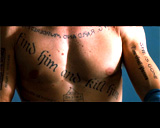
Leonard's Tattooed Body With Clues
|

Fact 5 and Fact 6
|
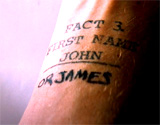
Fact 3: First Name John (or James)
|
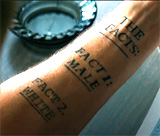
Fact 1 and 2: Male, White
|
- over lunch with Teddy, Leonard described what he
was vengefully investigating - the allegedly brutal and cold-blooded
rape and murder of his beloved wife Catherine (Jorja Fox); afterwards,
he returned to his hotel and realized he was being taken advantage
of and was paying for two rooms
- in the B/W segments, Leonard was often talking on
the phone from his motel room with an unidentified caller (Teddy)
- he related a revealing but semi-confused story
(intermixed with facts about his own life) about his first big
claims investigation of an insurance case; a client named Sammy
(Stephen Tobolowsky) (whose name was tattooed in cursive writing
on Leonard's left hand as "remember Sammy Jankis") was
a married, 58 year-old semi-retired accountant who had an accident
(a car crash) that damaged his hippocampus and also caused anterograde
amnesia (short-term memory loss); Leonard recounted how Sammy suffered
from apparent memory loss (like his own affliction)
- in Sammy's tragic case, he was dutifully administering
insulin shots for his diabetic wife Mrs. Harriet Jankis (Harriet
Sansom Harris); Leonard thought that Sammy was not really suffering
from memory loss, in order to receive a large insurance payout;
the company tested Sammy for months to see if he was a fraud; then
Leonard decided to expose Sammy during his investigation into his
mental condition; Leonard harshly denied Sammy's accident insurance
claim, arguing it was a psychological (mental) and not an objectively-real
physical problem, and as a result, the insurance company ruled
that Sammy wasn't covered for mental illness
- the ruling created a real hardship for Sammy's wife,
who then tried to get her husband to snap out of it: ("If
I just could say the right thing, he'd snap out of it and go back
to being normal") and came to visit Leonard's office to try
and persuade him to honor the claim; at the conclusion of the Sammy
episode in the film, Leonard (in a B/W segment) told his caller
that Sammy's wife found the ultimate way to test her husband's
memory ("his final exam") by repeatedly asking him to
administer her insulin shots ("She really thought she'd call
his bluff. Or she just didn't want to live with the things she'd
put him through") - and he obliviously and dutifully gave
her dose after dose after dose - until she died of an overdose
("She went into a coma and never recovered"), and Sammy
was institutionalized; it proved that Sammy wasn't a "con-man" and
that his wife's intentions were honorable:
"She wasn't interested in the money. She just needed to understand
his problem"
- in a side-plot, a helpful female bartender (from
Ferdy's) named Natalie (Carrie-Ann Moss) met up with Leonard in
a restaurant; she provided him with information (DMV search documents)
helpful to Leonard's search for his wife's murderer, although she
had inadvertently targeted Leonard's friend
"Teddy" (or John G) as a prime suspect; in exchange for
her help, Leonard returned the favor by going after angry drug boss
Dodd (Callum Keith Rennie); after the death of Natalie's drug-dealing
boyfriend Jimmy Grantz (Larry Holden) (killed by Leonard with Teddy!),
Dodd believed that Natalie was most likely hiding dead Jimmy's drugs
and drug money; to seek vengeful retribution and avoid being killed
by Dodd, Natalie (with bruises on her face) purposely manipulated
and urged Leonard to help her and retaliate against Dodd
- during a brief chase (on foot and by car), Leonard
realized he was being pursued by Dodd; because of his memory issues,
he became confused about what he was doing and the identity of
his pursuant; shortly later, the two confronted each other in Dodd's
Mountcrest Inn motel room (# 6) in town; Leonard bound and gagged
Dodd with duct-tape after a fight; ultimately, both he and "Teddy" coerced
Dodd to be driven out of town
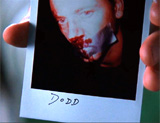
|
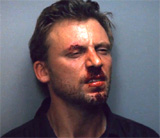
|
|
Dodd (Callum Keith Rennie) - A Drug Boss Threatened
Natalie After Suspecting That She Had Taken Off With Her Dead
Boyfriend Jimmy G's Drug Money
|
- about halfway through the film, "Teddy" tried
to convince Leonard that he was very confused ever since the "incident"
of his wife's murder-rape: "You don't have a clue, do you? You
don't even know who you are....You do not know who you are. What
you've become since the incident. You wander around playing detective.
You don't even know how long ago it was.... Maybe you should investigate
yourself"
- more information was presented by Leonard to Natalie
about the violent death of his wife, relayed in a flashback; Leonard
heard noises in their bathroom; he entered with his gun drawn and
found his wife being raped and strangled by a masked intruder after
being wrapped in a shower curtain on the bathroom floor; he shot
at the masked man and possibly killed him; Leonard was thrown into
a mirror (by the still-alive assailant, or a second unseen individual),
and suffered a severe blow to the head; he fell unconscious to
the bathroom floor next to his wife
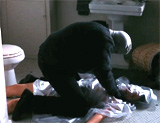
|
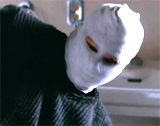
|
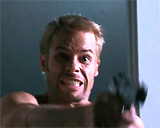
|
|
The Rape-Murder of Leonard's Wife
|
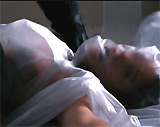
|
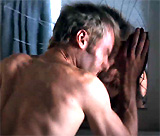
|
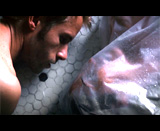
|
|
Leonard's Head Injury - Thrown Into a Mirror
|
- Leonard recalled to Natalie about his wife's rape-murder:
"There had to be a second man. Somebody hit me from behind.
I remember. It's the last thing I do remember"; however, Leonard's
account was untrustworthy and probably inaccurate; he stated that
the police didn't believe his assertion that two people were involved;
evidence at the crime scene did not confirm Leonard's firm belief
that there was a second individual (named John G) due to various
unproven assumptions he had made: "John G was clever. He was
clever. He took the dead man's gun and replaced it with the sap he
hit me with. He left my gun and the getaway car. He gave the police
a complete package. They found the sap with my blood on it in the
dead man's hand. And they only found my gun. They didn't need to
look for anybody else"; Leonard summarized: "I was the
only guy who disagreed with the facts and I had brain damage" -
so afterwards, he decided to pursue the case on his own
- at Emma's Tattoo Parlor, Leonard had submitted himself
to have Fact 5 and 6 tattooed on his left thigh; Leonard stated
verbally that Fact 6 was SG13 7IU, but the tattoo he received was
SG1371U (with two 1's); in the film, two versions of the license
plate were viewed; these discrepancies symbolized Leonard's unreliable
and confused state of mind
- in the tattoo parlor, "Teddy" instilled
fear into Leonard by telling him that a "bad cop" (was
he referring to himself?) had been looking for him, had checked
him into the Discount Inn and was repeatedly calling, and had slipped
things under his door; therefore, Leonard had to be careful (and
even change his identity and his clothes); "Teddy" specifically
mentioned that the cop was giving him "a line of crap about
John G being a local drug dealer,"
when the real drug-dealer was James F. "Jimmy" Grantz,
Natalie's boyfriend
- Leonard was very disturbed by Teddy's revelations;
it appeared that undercover cop "Teddy" was manipulating
and using the memory-damaged Leonard to kill a local drug-dealer,
Jimmy G (i.e., John G = Jimmy G), who had a similar name (John
or James) and the same occupation as his wife's assailant - a local
junkie; Leonard kept referring to his Polaroid picture of "Teddy" with
advice on the back: "DON'T BELIEVE HIS LIES" -
and doubted "Teddy's" truthfulness
- however, plotting was under way for Leonard and
Teddy to confront drug dealer Grantz; under "Teddy's" urging
and 'direction', Leonard drove to an abandoned building and assaulted
"Jimmy" Grantz who drove up; Grantz was forced to strip
off his clothes; in Leonard's mind, he regarded Jimmy as his wife's
2nd killer; with an ulterior motive, "Teddy" had set up
Leonard to do his dirty-work, to kill Jimmy and then abscond with
$200,000 of stolen drug money in his vehicle's trunk; Leonard didn't
care about the money, however; as he strangled Jimmy to death, he
revealed his real motivation - to avenge his wife's death: "I
want my f--king life back!"; after "Grantz" died,
Leonard took a Polaroid of his body, and then swapped clothes with
him (to change identities); as Leonard dragged Jimmy's body into
the basement, he thought he heard Grantz softly murmur: "Sammy" -
connecting everything together for him
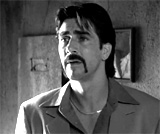
Jimmy Grantz - Natalie's Boyfriend (with Drug
Money), Confronted by Leonard (Who Had Been Sent by "Teddy")
|
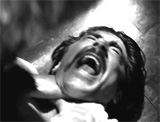
Leonard Sought Revenge For His Wife's Death by
Strangling Jimmy Grantz - Leonard Didn't Care About the Money
|
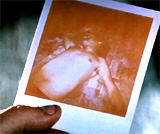
Leonard's Polaroid of Murdered Jimmy Grantz
|
- after killing Grantz, Leonard watched as "Teddy"
drove up to check up on him; Leonard became suspicious - not knowing
who "Teddy" was of course, and slugged him across the
head; undercover cop Teddy was exasperated with Leonard and tried
to reason with him and remind him: "I'm the guy that helped
you find him"
- "Teddy"
facetiously urged Leonard to be pleased about killing his wife's
rapist: ("He raped your wife, he f--ked up your brain");
he congratulated Leonard on successfully tracking down the suspected "John
G" (the rapist-murderer of Leonard's wife), and also admitted
how they would also make some money on the side: ("Look,
Leonard, Jimmy's your guy. I just figured we'd make a few dollars
on the side"); "Teddy" lied that Grantz' $200
grand was to buy amphetamines from him, but then claimed he would
split "half" with Leonard
- all along, Teddy knew the truth about the case,
but believed he could help Leonard by restoring some meaning to
his life (and find resolution about his wife) rather than having
him face reality; Teddy was clearly knowledgeable that Sammy's
story, in parallel fashion, was actually Leonard's story;
Leonard had projected his own life, and his accidental killing
of his own wife, onto Sammy (a fictional character); Sammy Jankis'
story was actually Leonard Shelby's story; Sammy NEVER really
existed as remembered by Leonard
- "Teddy" reminded Leonard (who had forgotten),
with a startling revelation, that he knew the 'truth' about Leonard
and his wife -- things which Leonard did not want to face, and
Teddy was attempting to convince Leonard to end his vengeful hunt:
("Great story. It gets better every time you tell it. So you
lie to yourself to be happy. There's nothing wrong with that. We
all do it. Who cares if there's a few little details you'd rather
not remember?...Your wife surviving the assault. Her not believing
your condition. The torment and pain and anguish tearing her up
inside. The insulin"); Leonard was disbelieving and insisted
that the insulin death of Sammy's wife wasn't related to him: "That's
Sammy, not me...Sammy let his wife kill herself. Sammy ended up
in an institution"
- "Teddy" equated Leonard with Sammy Jankis:
("Sammy didn't have a wife. It was your wife who had
diabetes"); Leonard had killed his own wife, when she expired
from a diabetic coma (not the rape!) caused by his insulin overdose;
Leonard's wife, who didn't believe his loss-of-memory condition,
had tested his short-term memory loss by demanding a succession
of shots of insulin; he forgetfully complied, and provided her
with too many insulin shots and she overdosed from the extra shots,
which sent her into a coma and killed her; as the film unfolded,
it was clear that Leonard had, ironically, remembered only some elements
about his wife's traumatic death, but only as a projection onto
a fictional accident insurance client named Sammy Jankis that he
was investigating
- however, Leonard denied that his wife was diabetic
("My wife wasn't diabetic") - because if she had been,
then it would have opened up the possibility that he had killed
her with extra doses of insulin
- "Teddy" continued to remind Leonard that
he thought he had gotten his revenge on his wife's rapist-murderer
by killing Jimmy G (or John G): ("Come on, you got your revenge.
Enjoy it while you still remember. What difference does it make
whether he was your guy or not?"; however, there was much
more that Leonard didn't remember
- "Teddy" made another shocking revelation
- that Leonard had already killed his wife's 2nd rapist-attacker
named John G. a year earlier: ("The real John G. I helped
you find him over a year ago. He's already dead...I was the cop
assigned to your wife's case, I believed you. I thought you deserved
a chance for revenge. I'm the one that helped you find the other
guy in your bathroom that night. The guy that cracked your skull
and f--ked your wife. We found him, you killed him. But you didn't
remember. So I helped you start looking again, looking for the
guy you already killed"; "Teddy" claimed he had
sympathized with Leonard and was attempting to convince Leonard
to end his vengeful hunt and that he was blindly avenging an act
that had already been avenged; the two killers were just a "couple
of junkies"
- "Teddy" pointed out to Leonard the Polaroid
photo that was taken a year earlier at the time of John G's bloody,
vengeful murder - and Leonard was very happy at the time; Teddy
stated he had given Leonard something to live for: ("I gave
you a reason to live and you were more than happy to help");
and then "Teddy" gave his own assessment of Leonard's disoriented
views: "You don't want the truth. You make up your own truth,
like your police file. It was complete when I gave it to you. Who
took out the twelve pages?"; acc. to Teddy, Leonard felt he
needed the unsolvable, puzzling hunt about his dead wife to give
himself a sense of purpose in life; Leonard was reminded that he
had removed 12 pages of the police case's file "to create a
puzzle you could never solve"
- Teddy tried to give himself credit for having pieced
the puzzle together to help Leonard find inner peace: "I'm
the one that put it all together. You, you wander around, you're
playing detective. You're living a dream, kid. A dead wife to pine
for, a sense of purpose to your life - a romantic quest that you
wouldn't end even if I wasn't in the picture"
- feeling threatened by everything that Teddy had
thrown at him, Leonard began to inaccurately turn his sights on "Teddy" (who
admitted his name was John G) - he suspected that "Teddy" was
the second murderous rapist-burglar of his wife
As the film ended after a complicated exposition of
facts and theories:
- Leonard emptied his gun, to fool himself into thinking
he wasn't a "killer" (voice-over: "I'm not a killer.
I'm just someone who wanted to make things right")
- he wrote on the Polaroid of
"Teddy": "DON'T BELIEVE HIS LIES" - to convince
himself that "Teddy" was the guilty 2nd rapist-killer.
Leonard confusingly suspected "Teddy"
was a rapist-killer - with the John G name; in the end, Leonard couldn't
face the fact that he himself was the killer that he had been searching for
- Leonard burned the Polaroids of Grantz' dead body
and of his own picture after murdering John G
- Leonard knew that he couldn't remember what "Teddy" was
telling him, and how he would continue his guilt-ridden vengeful
mission to search for a killer: ("Can I just let myself forget
what you've told me? Can I just let myself forget what you've made
me do? You think I just want another puzzle to solve?"); so
Leonard set up "Teddy" as his next 'John G' suspect,
although "Teddy" was innocent and was NOT the second
attacker of Leonard's wife ("Do I lie to myself to be happy?
In your case, Teddy, yes, I will")
- Leonard decided to copy "Teddy's"
license-plate number (SG13 7IU) on his '84 Chevrolet, although he
mistakenly wrote it (SGI3 7IU); he later used the license to
track down Teddy's whereabouts through DMV records (with Natalie's
help)
- although Teddy objected, Leonard stole Jimmy's car
keys and Jaguar car (with the money in the trunk): ("I think
I'd rather be mistaken for a dead guy than a killer") - and
drove off
- Leonard delivered a final voice-over while driving
away - with his eyes closed momentarily:
"I have to believe in a world outside
my own mind. I have to believe that my actions still have
meaning, even if I can't remember them. I have to believe
that when my eyes are closed, the world's still there. Do
I believe the world's still there? Is it still out there?...
Yeah. We all need mirrors to remind ourselves who we are.
I'm no different -- Now, where was I?
- he drove off to have the 'wrong' license number
tattooed on his leg at Emma's Tattoo parlor - to help him track
down the killer
- during his drive when he shut his eyes for a moment,
Leonard experienced a wish-fulfillment fantasy, with his wife next
to him caressing his chest, where he had tattooed: "I'VE DONE
IT"; he was satisfied that he had "solved' his wife's
rape/murder - again - by killing "Teddy" - the film's
opening (or closing) sequence in an abandoned building
|

Color Segment - Polaroid Photo of a Murder Scene Fading
From View
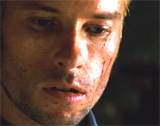
Polaroid Photo Held In the Hand of Protagonist Leonard Shelby (Guy Pearce)

Running in Reverse - The Opening Sequence (Chronologically the End Sequence)
- The Murder of Undercover Cop Teddy by Leonard
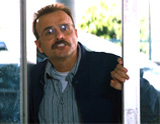
Cop "Teddy" Gammell (Joe Pantoliano) Before His Murder
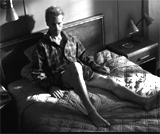
First B/W Sequence: Leonard in a Motel Room # 21 - With Memory Issues and Receiving
Phone Calls
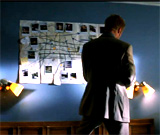
Leonard's 2nd Motel Room # 304 - With Hand-Drawn Map of Clues
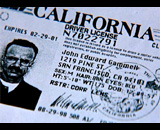
DMV Driver's License - Proof Provided by Natalie to Leonard That "Teddy" Was
John Gammell (or Suspect John G)

Tormented Protagonist Leonard
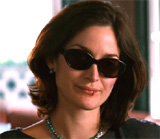
Natalie's (Carrie-Ann Moss) Last Meeting with Leonard in Restaurant
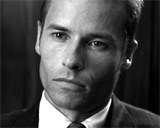
Leonard's Previous Career as an Insurance Fraud Specialist
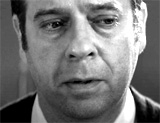
Leonard's Client Sammy (Stephen Tobolowsky)

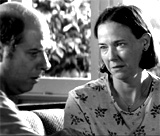
Repeated Insulin Injections that Killed Sammy's 'Wife'
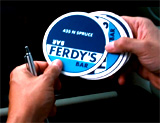
Ferdy's Bar - Where Natalie Worked as a Bartender - She Had a Drug-Dealing Boyfriend
Jimmy G.
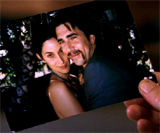
Natalie's Boyfriend Jimmy Grantz (Larry Holden) - A Drug Dealer
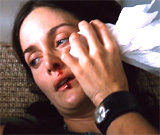
Natalie Pretending She Was Beaten Up By Dodd, In Order to Encourage Leonard to
Kill Dodd

Leonard's Brief Affair with Natalie - And The Exchange of Helpful Favors

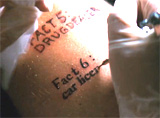
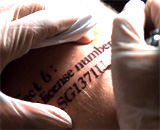
Emma's Tattoo Parlor - Where Some of Leonard's Tattoos Were Administered

Polaroid of "Teddy" (Officer John Gammel)
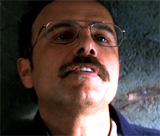
"Teddy's" Startling Revelation to Leonard That Sammy Jankis' Story
Was Actually Leonard's Story
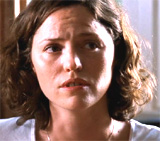
Leonard's Wife - A Diabetic Who Was Tormented by Leonard's Memory Loss

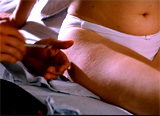
Leonard Was Tested to Deliver Insulin Shots to His Wife, and She Overdosed

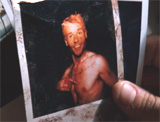
Polaroid Taken Just After Leonard Killed John G, a Year Earlier


Leonard Transcribing Teddy's License Plate (To Be Tracked Later)

Ending: Leonard Driving Away ("Now, where was I?")

With His Eyes Closed, Leonard's Wish Fulfillment - He Imagined His 'Dead' Wife
- Leonard's Final Voice-Over (Tattoo: "I'VE DONE IT")
|
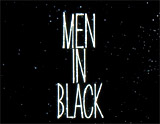
|
Men in Black (1997)
 Earth
Was Saved From an Inter-Galactic Alien War by the MIB Agents; Agent K
Retired (After Being Neuralized), and Dr. Weaver Became Replacement
Agent L Earth
Was Saved From an Inter-Galactic Alien War by the MIB Agents; Agent K
Retired (After Being Neuralized), and Dr. Weaver Became Replacement
Agent L
The Men in Black of the film's title originally
referred to a sci-fi comic book series, first published in 1991,
about a top-secret organization of agents that monitored, regulated
and policed paranormal and alien activity on Earth. There were two
film sequels to the 1997 release, in 2002 and 2012.
In all three science-fiction comedies, there were two
starring MIB agents, named after their black suits, shoes, ties,
and sunglasses. In this first of the series from director Barry Sonnenfeld,
J (with his memory and his life as a private citizen entirely erased)
had been recently recruited to join older partner K:
- K or "Kay" (Kevin Brown) (Tommy Lee Jones), humorless,
cold, world-weary
- J or "Jay" (James Darrel Edwards III)
(Will Smith), originally an NYPD detective, anti-authoritarian,
with a wise-cracking, flippant attitude (J to K: "You know what
the difference is between you and me? I make this look good")
Their task was to
save the Earth from destruction by inter-galactic terrorist forces.
Extraterrestrial lifeforms were living on Earth and hiding their
existence from ordinary humans. When the MIB agents terminated an
alien, they used a Neuralyzer (in the shape of a cigar
tube) to wipe the memories of witnesses
and other humans, to ostensibly protect them and hide the existence
of extra-terrestrial alien life-forms from human knowledge. A bright
red flash from the device would wipe the memories of the past hours,
days, weeks, months or years, depending on the settings. The two
MIB agents wore sunglasses to reflect the neuralyzer rays so they
wouldn't be affected.
In their investigations in Manhattan (where most aliens
were hiding) to protect humans from the "scum of the universe," they
discovered the makings of an inter-galactic war between rival extra-terrestrial
aliens.
- Aggressive, evil cockroach-like aliens-assassins
("bugs")
- Arquillian royal family aliens
One of the galactic rival insectoids had
taken over and was concealed inside the body of innocent country
bumpkin Edgar (Vincent D'Onofrio) - thus Edgar Bug.
At the morgue with deputy
medical examiner Dr. Laurel Weaver (Linda Fiorentino), the two agents
examined the head of one of the bodies that was killed by the
alien "Bug." There, they
found a dying, human-looking Arquillian alien, named Gentle Rosenberg
(Mike Nussbaum). Gentle Rosenberg was actually an exiled member of
an alien royal family. Before dying, Rosenberg revealed
the location of the much sought-after miniature galaxy (a massive source
of energy) - it was concealed in the neck 'belt' or collar of Rosenberg's
cat named Orion:
"To prevent war, the galaxy is on Orion's belt."
 Gentle Rosenberg - An Arquillian Alien, Inside the
Head of a Corpse
Gentle Rosenberg - An Arquillian Alien, Inside the
Head of a Corpse
|
 "The galaxy is on Orion's belt"
"The galaxy is on Orion's belt"
|
The stolen galaxy and the death of Rosenberg
sparked the warfare.
An ultimatum to the MIB agents gave them only
one hour to acquire and return the galaxy to the Arquillians, or
Earth would be destroyed. The miniature galaxy was seized by Edgar,
Dr. Weaver was kidnapped from the morgue, and Edgar flew off in a
flying saucer. After the spacecraft was shot down by the two
agents, the evil alien bug revealed itself when it peeled away the
Edgar shell.
When the "Bug" was finally destroyed with the
help of coroner Dr. Weaver (after both agents
were covered with slime from the belly of the creature after K was
expelled), the galaxy was recovered.
K revealed he was not training J as a partner, but as
a replacement after he retired:
They're beautiful, aren't they?
Stars...I never look at them anymore, but they actually are quite...beautiful...
I haven't been training a partner, I've been training a replacement.
There was a sweet, heartfelt conclusion - K instructed
J how to use the amnesia-creating Neuralyzer to erase his memory:
Days...
Months... Years. Always face it forward.
Before J could protest, K told him in a tortured voice:
I've
just been down the gullet of an interstellar cockroach, kid, and that's
one of a hundred memories that I don't want.
After Agent K was zapped and neuralized (with an erased
memory), he lived happily ever-after reunited with his wife, and he
appeared on the cover of the National Enquirer (in
a lead story about having awakened from a 35-year coma). The cover photo
showed K standing with his wife while giving her flowers.
And now, Dr. Weaver was
Agent J's replacement partner Agent L, wearing the all-black uniform.
The film famously ended with a bizarre non-sequitur pull-back
(or zoom-out) sequence - starting in Manhattan, then pulling back to
the Earth and the Moon, then the Solar System and the vast Milky Way
galaxy. Everything was shown to be inside a spherical marble (representing
a galaxy). The marble was a play toy that was being used in a game
with other marbles (or galaxies). The tentacled hand of a green alien
picked up the marbles, and dropped them into a collection
bag of many marble-galaxies. |

James Edwards (Will Smith) Before Becoming Agent J

MIB Agents: K and J

Dr. Laurel Weaver (Linda Fiorentino)

The Neuralyzer

Orion's Belt (Collar) Holding a Miniature Galaxy

Edgar Bug (Vincent D'Onofrio)


The Aggressive Inter-Galactic
Alien Insectoid ("Bug")

The Recovered Galaxy - in Alien Belly Slime

National Enquirer Headline After K's Retirement


The Zoom-Out Shot and the Alien's Bag of Marble-Galaxies
|
